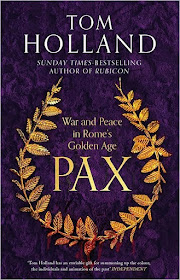WARRIOR - Edge of Empire (Book Three)
by Alistair Tosh
Best
selling author, Alistair Tosh was born in Dumfriesshire, a place
filled with ancient place names such as Torthorwald and Caerlaverock.
But it was his visits, as a boy, to nearby Burnswark Iron Age
hillfort and its Roman siegeworks that first fired his interest in
Roman and Dark Ages history.
On
leaving school he began a 35 year communications career, firstly with
the Royal Navy, that included covert riverine and seaborne operations
during the height of ‘The Troubles’ in Northern Ireland, before
moving into the corporate telecommunications world. Military life is
unique, and Alistair aims to reflect an authentic view of that
experience and its language in his stories.
His
debut historical novel, Siege, the first book in the Edge of Empire
series, is set against the backdrop of the Antonine push into
Caledonia. Lucius Faenius Felix, cheated of his ancestral estates and
still grieving the murder of his father, arrives in Britannia as an
inexperienced Tribune to command the First Nervana. A cohort drawn
from the homelands of the fierce Nervii tribe. With the comradeship
of Cai Martis, the veteran cavalry Prefect, he endeavours to uncover
the conspiracy of the resurgent Novantae people.
Praise
for the Edge of Empire series
"An
excellent, exciting debut. Gripping, gritty, and blood-spattered.
Fans of Roman historical adventure will love it! Alistair Tosh is a
writer to watch." Matthew Harffy, Author of the Bernicia
Chronicles.
"A
taut bowstring of a story with a climax sharp as a warrior's blade."
Alistair Forrest, author of Sea of Flames
"Tosh
takes his band of heroes through an ancient heart of darkness. An
epic adventure that will leave warriors changed and have the reader's
pulse-rate soaring." Fiona Forsyth, author of the Lucius Sestius
Mysteries
Book
3 in the series 'Warrior' is now out now
When
not writing or researching, Alistair likes to spend time with family.
He and his wife also love hill walking and have spent a great deal of
time exploring the mountains of both the UK and Andalucia accompanied
by their dog Hurley.
WARRIOR - Book
Summary
'The
ultimate blend of betrayal, vengeance and brutality in this
thunderous thriller set in Roman Spain.' Fiona Forsyth, author of
Rome's
End
AD
150
Lucius
Faenius Felix - a battle hardened Tribune, scarred in body and mind -
journeys to his home province of Hispania Baetica. Accompanied by his
friend Cai Martis - warrior of the Nervii tribe and veteran Praefect
of cavalry - Felix has high hopes of recovering his family lands and
avenging his father’s murder.
But
the soldier's homeland is being terrorised by roving bands of
outlaws. Felix and Martis are thrust into a perilous world of
powerful men and rival factions. When his brother is captured by one
of the gangs Lucius goes in pursuit with his own small band and
unwittingly starts a war with a formidable enemy who are not what
they initially seem.
Felix's
honour is tested when told he must forgo seeking revenge against his
father’s killer, Malor, the head of the villainous Castricae clan,
as the price for the return of his lands.
Friends
and enemies are not always what they seem, as Felix draws Malor’s
forces in to give battle.
The
soldier will risk everything to see his sense of honour - and desire
for vengeance - satisfied.











.jpg)

